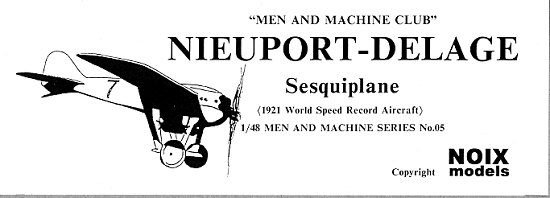
| KIT: | Noix Models 1/48 Nieuport-Delage Sesquiplane |
| KIT #: | 05 |
| PRICE: | $95.00 from www.coopersmodels.com |
| DECALS: | Two options |
| REVIEWER: | Scott Van Aken |
| NOTES: | Resin with metal parts. |

| HISTORY |
During WWI, aviation technology advanced considerably in aerodynamics, structures and power plants. However, speed was not the major motivating factor when building military aircraft as these planes had to carry weapons and have a reasonable range, things that generally add weight and so reduce speeds.
Post war, sport aviation came back and one of the leading countries in this area was France, with several successful aircraft manufacturers seeking the elusive speed record. Gustav Delage, the chief designer of Nieuport and the eventual owner of the company, developed a speedy looking sesquiplane design in 1921 designed to capture the record after several attempts using ex military Nieuport 29 types.
This new aircraft was a shoulder-wing design with a tiny lower wing that acted as part of the landing gear. It was powered by a Hispano-Suiza V-8 of 300 horsepower. While the barrel fuselage was adapted from the Nieuport 29, it had twin Lamblin barrel shaped radiators mounted on the landing gear struts.
Two aircraft were built and numbered 6 (with a red tail) and 7 (with a blue tail). September 26 1921 was when pilot Sadi Lecointe flew #6 and was able to achieve an official world speed record of 330 km/h. Five days later, this plane and pilot were entered in the Coupe Deutsch race but crashed shortly after taking off, writing off the aircraft and injuring the pilot. The cause was thought to be a fractured propeller, but is now believed to have been due to wing flutter, a phenomenon not known at the time.
| THE KIT |
 Noix
produces world class kits. The resin is flawless and so are the metal pieces
provided. This is a case of paying for the very best. The lower fuselage
includes the cockpit and has the horizontal stabilizers molded in place. There
are slots for the various interior bits, including the prop shaft. The upper
wing and upper forward fuselage are molded into a single piece and fit along a
natural seam line. In fact, if one is smart, one will paint the upper cowling
before attaching it to the lower after first being sure of a clean join line.
The fin is also in resin as is the seat and a set of wheels. The lower
airfoil/wheel brace has a metal axle imbedded in it.
Noix
produces world class kits. The resin is flawless and so are the metal pieces
provided. This is a case of paying for the very best. The lower fuselage
includes the cockpit and has the horizontal stabilizers molded in place. There
are slots for the various interior bits, including the prop shaft. The upper
wing and upper forward fuselage are molded into a single piece and fit along a
natural seam line. In fact, if one is smart, one will paint the upper cowling
before attaching it to the lower after first being sure of a clean join line.
The fin is also in resin as is the seat and a set of wheels. The lower
airfoil/wheel brace has a metal axle imbedded in it.
Cast metal is used for the gear struts, exhaust, radiators, control stick, tail skid, another set of wheels in case you'd rather use metal ones, prop, shaft and a few smaller bits. A section of acetate is provided for the windscreen and a template is on the instructions. A small sheet has both the racing numbers (not shown).
Two sets of instructions, one in English and the other in Japanese are provided. There is a construction sequence written in both along with a couple of exploded views. Color information and a parts listing are also given. Both aircraft are basically white with colored tails; one Red and the other in French Blue. A color photo of both options is included in the sturdy box. A small rigging diagram for the gear struts is provided.
| CONCLUSIONS |
It is not an inexpensive kit, but the best rarely is. The lack of fiddly bits is very much appreciated and with that in mind, the kit should build relatively quickly compared to many resin kits. It is basically a case of providing something rare and different to you as I can pretty well guarantee that you won't see many of these aircraft around!
My thanks to www.coopersmodels.com for providing the review kit. You can get yours by following the hyperlink. You'll be glad you did.
June 2007
If you would like your product reviewed fairly and quickly by a site that has nearly 350,000 visitors a month, please contact me or see other details in the Note to Contributors.